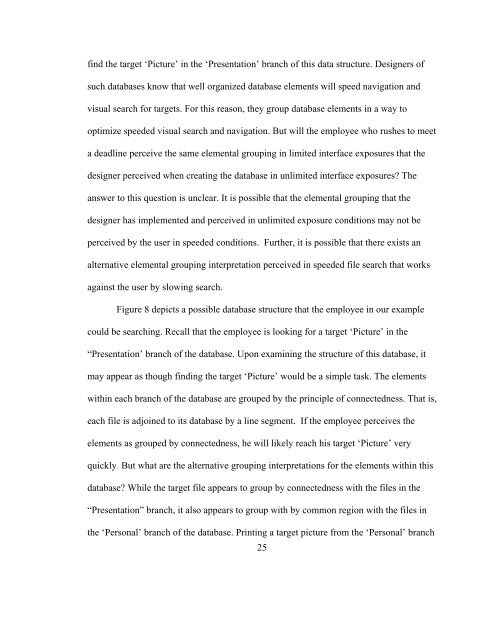The Use of Iambic Pentameter in the
The Use of Iambic Pentameter in the
The Use of Iambic Pentameter in the
Create successful ePaper yourself
Turn your PDF publications into a flip-book with our unique Google optimized e-Paper software.
f<strong>in</strong>d <strong>the</strong> target ‘Picture’ <strong>in</strong> <strong>the</strong> ‘Presentation’ branch <strong>of</strong> this data structure. Designers <strong>of</strong><br />
such databases know that well organized database elements will speed navigation and<br />
visual search for targets. For this reason, <strong>the</strong>y group database elements <strong>in</strong> a way to<br />
optimize speeded visual search and navigation. But will <strong>the</strong> employee who rushes to meet<br />
a deadl<strong>in</strong>e perceive <strong>the</strong> same elemental group<strong>in</strong>g <strong>in</strong> limited <strong>in</strong>terface exposures that <strong>the</strong><br />
designer perceived when creat<strong>in</strong>g <strong>the</strong> database <strong>in</strong> unlimited <strong>in</strong>terface exposures? <strong>The</strong><br />
answer to this question is unclear. It is possible that <strong>the</strong> elemental group<strong>in</strong>g that <strong>the</strong><br />
designer has implemented and perceived <strong>in</strong> unlimited exposure conditions may not be<br />
perceived by <strong>the</strong> user <strong>in</strong> speeded conditions. Fur<strong>the</strong>r, it is possible that <strong>the</strong>re exists an<br />
alternative elemental group<strong>in</strong>g <strong>in</strong>terpretation perceived <strong>in</strong> speeded file search that works<br />
aga<strong>in</strong>st <strong>the</strong> user by slow<strong>in</strong>g search.<br />
Figure 8 depicts a possible database structure that <strong>the</strong> employee <strong>in</strong> our example<br />
could be search<strong>in</strong>g. Recall that <strong>the</strong> employee is look<strong>in</strong>g for a target ‘Picture’ <strong>in</strong> <strong>the</strong><br />
“Presentation’ branch <strong>of</strong> <strong>the</strong> database. Upon exam<strong>in</strong><strong>in</strong>g <strong>the</strong> structure <strong>of</strong> this database, it<br />
may appear as though f<strong>in</strong>d<strong>in</strong>g <strong>the</strong> target ‘Picture’ would be a simple task. <strong>The</strong> elements<br />
with<strong>in</strong> each branch <strong>of</strong> <strong>the</strong> database are grouped by <strong>the</strong> pr<strong>in</strong>ciple <strong>of</strong> connectedness. That is,<br />
each file is adjo<strong>in</strong>ed to its database by a l<strong>in</strong>e segment. If <strong>the</strong> employee perceives <strong>the</strong><br />
elements as grouped by connectedness, he will likely reach his target ‘Picture’ very<br />
quickly. But what are <strong>the</strong> alternative group<strong>in</strong>g <strong>in</strong>terpretations for <strong>the</strong> elements with<strong>in</strong> this<br />
database? While <strong>the</strong> target file appears to group by connectedness with <strong>the</strong> files <strong>in</strong> <strong>the</strong><br />
“Presentation” branch, it also appears to group with by common region with <strong>the</strong> files <strong>in</strong><br />
<strong>the</strong> ‘Personal’ branch <strong>of</strong> <strong>the</strong> database. Pr<strong>in</strong>t<strong>in</strong>g a target picture from <strong>the</strong> ‘Personal’ branch<br />
25

















